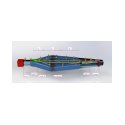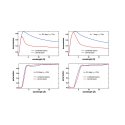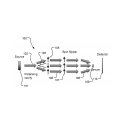Tasks and partners
Advanced methods and techniques
Task 1: Sub-mm3 samples for extreme environments
Task co-ordinator: Phil Bentley (ESS)
Partners: ESS, ILL, ICMA Zaragoza
The impact of neutron scattering science is severely limited by the inherently low brightness of the available neutron sources. Even with the order-of-magnitude increase in brightness from the ESS, the source brightness will remain the limiting factor in many circumstances. The problem is exacerbated when the sample under study needs to be studied under extreme conditions of pressure, magnetic field, or temperature. Common to these sample-environment parameters is that the extreme condition can only be applied over a very small volume. In addition, the available solid angle for detectors is also severely reduced, resulting in often unfeasibly long counting times or the signal falling below the threshold set by background noise. We propose to address this in two ways:
- To develop software for multi-channel neutron focusing guides for extreme sample environments.
- Design a focusing guide for a realistic experimental setup such as the IN5 or ThALES instruments at ILL.
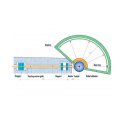
Task 3: Spin Echo with Oscillating Intensity for the ESS
Task co-ordinator: Wolfgang Häußler (TUM)
Partners: TUM, TU Delft, STFC
This task is devoted to developments for the application of Neutron Spin Echo (NSE) techniques at spallation sources, especially at the ESS. The neutron resonance flip coils used in Neutron Resonance Spin Echo (NRSE) and its variant MIEZE (modulation of intensity with zero effort) produce a static magnetic field and a radio frequency (RF) field. Correctly tuned with respect to the neutron wavelength, this combination leads to resonant spin flips of the neutron polarization. Together with the phase information from the radio frequency (RF) current this allows for detecting of the MIEZE signal in an appropriate detector.
At pulsed beamlines, the amplitude has to be adjusted to the wavelength distribution in one neutron pulse, where the wavelengths arriving at the NRSE coils are linearly increasing with increasing time. Moreover, in order to repeat measurements, in order to increase the statistical accuracy, the phase of the NRSE RF currents has to be synchronized for each neutron pulse.
While for NSE at a pulsed neutron beam detectors are needed being comparable to other instruments like Small Angle Neutron Scattering (SANS) or diffraction instruments, special detectors with high time resolution are required for the NSE variant MIEZE (modulation of intensity with zero effort).
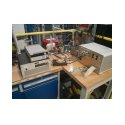
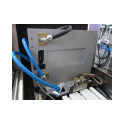
Task 4: Choppers for the ESS instrumentation
Task co-ordinator: Michael Monkenbusch (Jülich)
Partners: Jülich
The ESS is planned as intense long pulse neutron source with an effective neutron pulse length of the order of 2.8 ms at a repetition frequency of 14 Hz. With these parameters it is obvious that at least for all instruments that do not correspond to reactor instruments with velocity selectors (i.e. SANS, NSE, reflectometry) additional pulse shaping is required to achieve a reasonable resolution. This pulse shaping has to be performed by some kind of choppers. One task certainly is to modify existing chopper families (Fermi choppers, disk choppers with and without magnetic bearings) such that they meet the harsher radiation requirements of the ESS environment. However, to fully exploit new ideas, e.g. employing repetition rate multiplication, focusing in time, energy and/or even space, choppers with extended capabilities are needed to realize the solutions with optimum neutron usage. Here we are investigating the capabilities, properties and feasibility of new chopper concepts that may allow for high frequency (KHz), large area and adaptability to focusing strategies. At the same time the kinetic energy shall be limited such that safety issues do not prevent their practical use. The idea is to compose a Fermi chopper type by an array of slim rotators that are operated synchronously and eventually with adjustable phase shifts. To cover a larger area, a staggered array of these rotors with small diameters is needed.
We investigate drive concepts that allow a slim shape needed for a scalable staggered system. Here the precise phase control is one issue. Further the mechanical properties of rotors with Fermi packets are studied to explore the limits of rotation frequency. The aim is to provide design guides for scalable large area Fermi choppers that despite high rotation frequency contain only a rather limited kinetic energy. By adapted phasing concepts such choppers may be operated in different customized focussing modes.
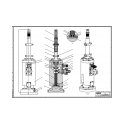
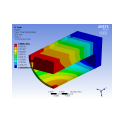
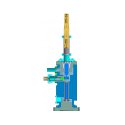
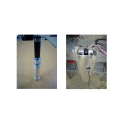
Task 5: Polarising all neutrons in a beam
Task co-ordinator: Katia Pappas (TU-Delft)
Partners: TU-Delft, ESS
Current polarisers select one of the two spin-states of the neutron beam and discard the other. For cold neutron beams it should be possible to take advantage of the long target-instrument distances, which result from the low repetition rate of the ESS, and polarise the totality of the beam by combining polarizing supermirrors in reflection and transmission. In this way it will possible to produce two beams with opposite polarisations, flip the polarization of one of the beams (e.g. with a broad band radiofrequency flipper) and recombine them. To satisfy Liouville’s theorem, phase space volume necessarily increases, either in divergence, wavelength or time. On the other hand, the resulting very high intensity polarized neutron beams will be unique and will mark a qualitative lap in neutron scattering by enabling the full exploitation of the unique capabilities of the neutron spin.
At a first stage Monte Carlo simulations will be used to calculate and check the whole concept. The optimization procedure should identify the best trade-off between polarization efficiency, transmission, beam profile
homogeneity, beam divergence, etc. In addition the simulations will look into the possibility of combining such a device with focussing-geometry guides and/or of switching between “one beam” high-resolution/low-intensity and “combined beams” low-resolution/high-intensity configurations on the same instrument. The extensive simulation and optimization work shall explore the potential of this concept and should lead to generic setups, which at a later stage will be realized and tested as low-scale prototypes.
